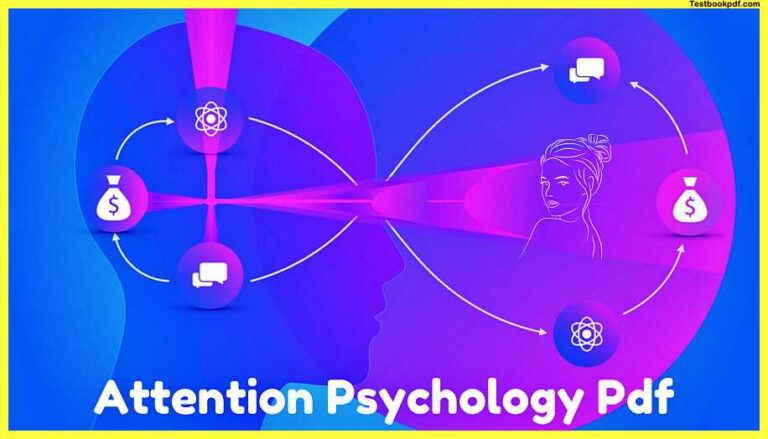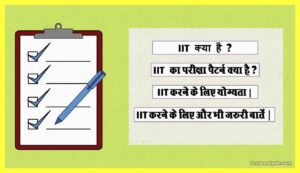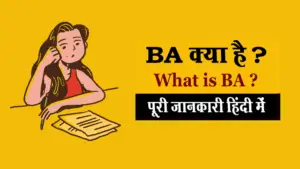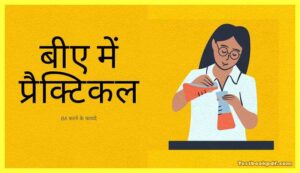Attention Psychology Pdf (Part-2)
This article is on Selective Attention, Attention Psychology Pdf (Part-2) It covers the phenomenon of the cocktail party effect and theories of selective attention (filter and bottleneck theories). It also covers various models (Broadbent model, Selective filter model, Attenuation model, Late-Filter model) and neuroscience of selective attention.
If you remember what I was telling in the last lecture was this very interesting experiment or very interesting finding that colin cherry found out and this finding was referred to as the cocktail party effect.
So, it often happens just to give you a brief recap it would often happen in a public gathering like in parties or restaurants or in a busy classroom where you are talking to somebody you are engaged in this particular conversation but there are still some other conversations going around and suddenly someone in those other conversations wherein you are not really involved and they are probably 10-50 meters away from you somebody mentions your name you quickly get oriented towards that particular conversation you do notice something that somebody took your name maybe even though that person is not really talking to you is talking to somebody else and is sitting say for example 20 meters away from you it does happen.
Now, why is this happening you were at a cross in a particular conversation you were attending to the person’s got oriented to your name in the other conversation there are two important things here first is that that particular conversation is also in some sense probably being processed in your head so that you could notice that the second is not any other information you might so distinctly remember but you remembered that your name was taken.
Selective Attention
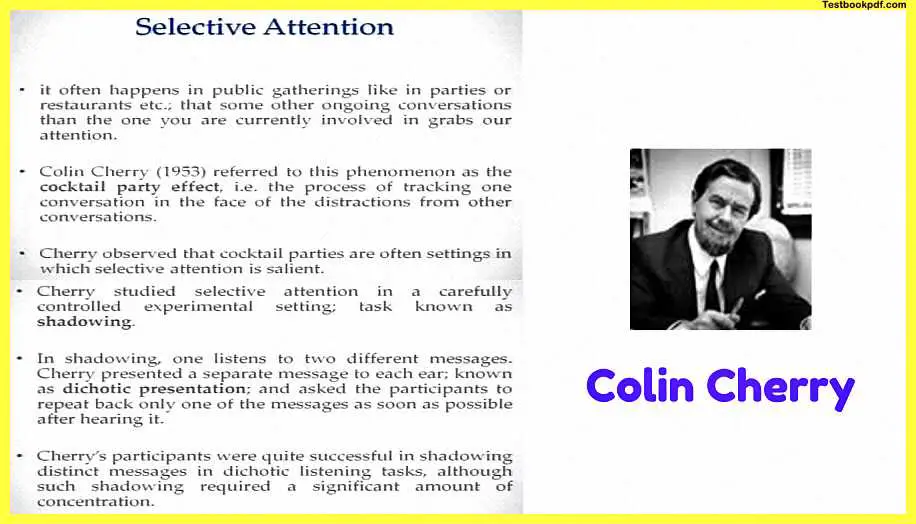
So information that is relevant to you was in some way prioritized and had more attention so that you quickly looked to it so you have to look at the the attentional system in such a way that it is doing at least two things it is prioritizing and information relevant to you is probably at a much higher priority than any other kind of information and also the second thing is that other kinds of information are also being processed even though they are not actively engaged in while you are listening to that or processing that so this is this is something which is important and in today’s lecture we we will be talking about selective attention different theories of selective attention and we will be talking about on though all the those theories with reference to Colin Cherry’s work ok so Colin Cherry observed that cocktail parties are often settings wherein selective attention is very salient see there is a lot of hustle and bustle there’s a lot of things going on too many people are talking.
So you have to really keep up your selective attention game at the best so that you can at least listen to somebody if you are saying for example in fairs or in very busy crowded malls obviously sometimes to even attend to the person walking next to you becomes difficult so your selective attention is working overtime to help you at least understand one conversation that you are part of ok so this is just me my picture from the internet.
Dichotic Presentation
Let us now talk about how Colin Cherry was interested in studying selective attention Colin Cherry was in he actually studied selective attention a very carefully controlled experimental setting and he used a task which is referred to as shadowing what happens is that one is listening to different kinds of messages so Colin Cherry presented a separate message to both the ears so one year receives another message the other area receives a different kind of message this important task of giving two different kinds of messages two different kinds of signals or even sometimes two same kinds of signal to both the ears depending on what your experimental design is is called the dichotic listening task.
so this presentation was called dichotic presentation where you are presenting a separate message to each ear and he asked this participant he has these subjects of his experiment to repeat back only one of the messages and as soon as possible after hearing it cherries participants so this is the setup basically again something borrowed from the demonstration is bought from Sternberg and Sternberg.
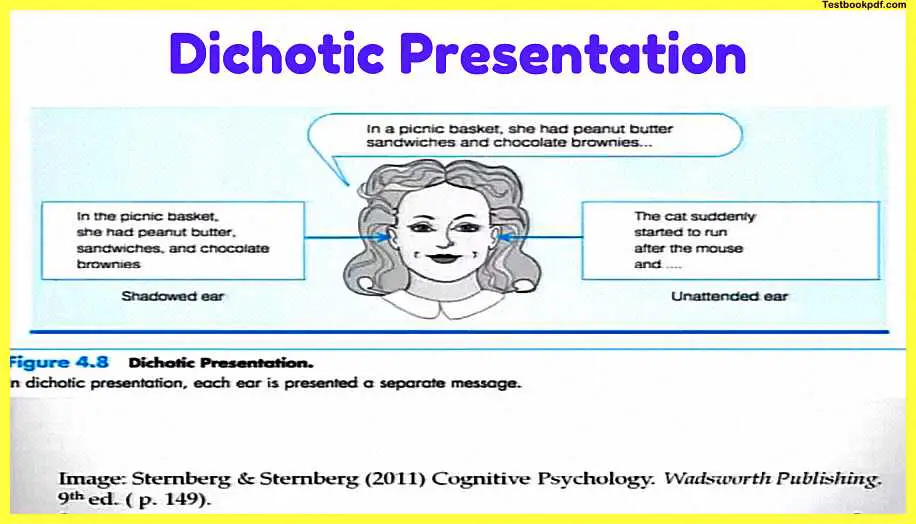
So you can see that this lady is getting two different kinds of messages in the two years so in one year is she is hearing in the picnic basket she had peanut butter sandwiches and chocolate brownies in the other year she is hearing the cat suddenly started to so you see these two messages qualitatively different as well and she is shadowing say from the shadowed ear she is repeating that message out these participants, in general, were quite successful in shadowing distinct messages in these dichotic listening tasks although such shadowing required a significant amount of concentration if you kind of pick up two phones and start talking with two people at the same time you will find that it’s so confusing it’s so difficult to even listen to what these two people are saying leave alone the repeating part these participants, however, were also able to notice physical or sensory changes in the unattended message as well.
So you might think that all the concentration is spent in just shadowing one of the ears and repeating that but cherry noticed that these participants were actually noticing if there were any physical or sensory changes made in the unattended message remember this is not the shadowed year when the message the unattended message that is was changed to a tone if they were just a beep and here the message in the picnic basket is playing or say for example here the cat was suddenly was being said by a male and suddenly now it is being said by a female they also would notice it.

Now, however, they did not really notice the semantic changes in the unattended message if the meaning would change they will not notice that they also fail to notice even when the unattended message was shifted from german to English or was started to play backward those kinds of things they did not really notice so they’re doing some analysis with the message in the unattended here but they’re not really doing this analysis to a semantic level wherein you’re kind of really understanding that as well it’s that’s where probably the resource limitation would come in now conversely about one-third of these people when their name was presented in during this kind of situation shifted their attention to their name so even if in the unattended year their name was presented they would quickly grab it and quickly attend it.
Now some researchers have noticed that these people who do hear their name even in the unattended message wherein a concentrated task is going on in the shadowed year may have what is called limited working memory capacity and thus are easily distracted and have lower amounts of concentration there.
So your working memory capacity just kind of gets filled up and then you kind of are very distracted towards all the other things that you are hearing now if you kind of try and analyze this how this is happening what are the findings of this experiment and how you can make sense of them three factors will help you to understand it there will be three factors that will help a person to selectively attend the target speaker if say for example you’re caught in a busy restaurant or those kind of settings.
Now distinctive sensory characteristics of the targets say for example somebody has a very peculiar voice you must have heard everybody make fun of Sachin Tendulkar’s voice so if there is a distinctive characteristic of that particular voice you will probably attend it better the second is the sound intensity if the person speaks very loudly versus other speaks very slowly it becomes that difficult if the person speaks rather loudly you will certainly that will grab your attention and you listen to that the third is the location of the sound if it’s coming very close to you it’s coming from slightly further away from you sometimes you would have seen that people find it difficult to hear issues and then they will call the person they are talking to and come and sit next to me and then they will have the conversation so these are the three sources three features of the persons of the target person’s voice that might help you to concentrate on them better.
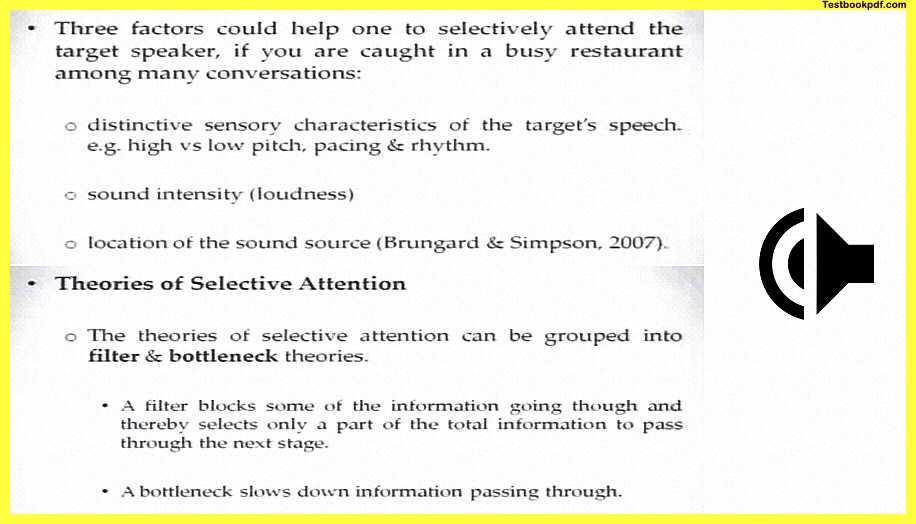
Now let us talk about theories of selective attention now there will be a few theories we will be talking about these theories can be grouped into filter theories and bottleneck theories very broadly speaking a filter theory basically says that there is a filter that blocks some of the information going through and thereby selects only a part of the total information to pass through the next stage a bottleneck basically says that a bottleneck is going to slow down the information passing through though all the information will pass.
So this is the distinction between filter theories of attention and bottleneck theories of energy just to repeat a filter theory is saying that some of the information will be blocked from going through and only a part of this total information will pass so something that you have not selected kind of stays outside the perceptual thing the second theory says that everything will pass but there will be a bottleneck so there will be some kind of a capacity limitation of handling the information so this is these are the two things you have to remember.
Now two questions one can ask say for example if there is a filter being applied whether there is a distinct filter for all kinds of incoming information so auditory information there is other filters visual information other filters if is that does that happen this way the second is where in this entire processing the filter will be put will it be put at the initial at the earliest stage that all the information is coming this passing through filter only some information really get through get past you and get past your brain where you understand it or you put the information slide i put the filter much later.
So that all the information coming in get processed to some particular stage but wherever the most relevant and important stages where the filter is and so that you are kind of just processing the most processing happens only for a limited set of information while basic process probably apply to all the other information that are coming so these are the two kind of questions you can ask if you are talking about these filter theories one of the very important filter theories is the Donald Broadbent’s theory on Broadman basically said that we are filtering information right after we notice it at the sensory level so it is an early filter kind of a theory so we are kind of filtering out information at the sensory level itself multiple channels of sensory input reach an attentional filter those channels can be distinguished by their characteristics like loudness pitch or accent say for example there are multiple people speaking in a busy room and you’re kind of just prioritizing or each of them is salient in one way or the other by the incoming information.
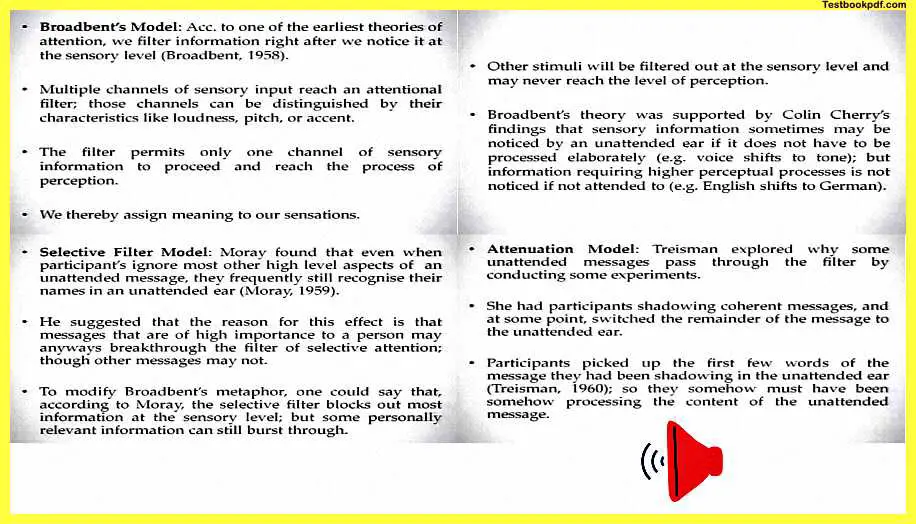
Now the filter permits only one channel of sensory information to proceed and reach the process of perception thereby after this we will assign meaning to our sensations ok so the filter has to basically select from these different kinds of information but it will basically really permit only one of the pieces of information to pass through this filter and that is the one which you will be able to analyze completely and assign meaning to other stimuli that you have left out will be filtered out at the sensory level itself and you will never reach to the level of perception ok if you remember from the sensation and perception class sensation is the just the analysis of incoming information perception is about assigning meaning to that evaluating whether this information or not those kinds of things.
Now broadband’s theory was supported by colin cherry’s findings that sensory information may sometimes be noticed by an unattended ear if it does not have to and even if it does not have to be processed elaborately say for example if the voice was shifting from towards the tone or the male voice was being converted to female voice it was still being attended but information requiring higher perceptual processing say for example knowing the language of the message that will happen even if this is not attended to so there is this distinction that is happening another model that we can talk about is the selective filter model.
Now Murray basically found out that even when participants are ignoring most of the other higher-level aspects of an internet message they do frequently recognize their names in an attended unattended year so the filter is not really that hard it is not really that strict in that sense and information that is like things like your name do pass on he suggested that the reason for this effect is that the messages are that are of high importance to a person may anyways break through the filter of selective attention so if say for example somebody says your name somebody is talking about people from your family somebody’s talking about something that you’re very interested in say, for example, a conversation about cricket that might still be relevant to you in a special way and you might still attend it might still grab your attention.
Now to modify broadband’s metaphor in light of these findings one could say that according to Murray the selective filter blocks out most of the information at the sensory level but some personally relevant information still passes off so the filter is not really a very strict filter and keeps everything out and not getting them processed but everything that is relevant to you something that you really like some conversation about cricket or football or whatever you’re interested in will still be heard imagine yourself traveling in metro and some people is talking about your favorite players you might still attend that even though you’re not really part of that conversation you’re busy doing something else.
Anne Treisman
Now the third model that we can talk about another different kind of model is called the attenuation model now Anne Treisman tried to explore why these unattended messages pass through the filter and she kind of tried to explore this by doing certain kinds of experiments.
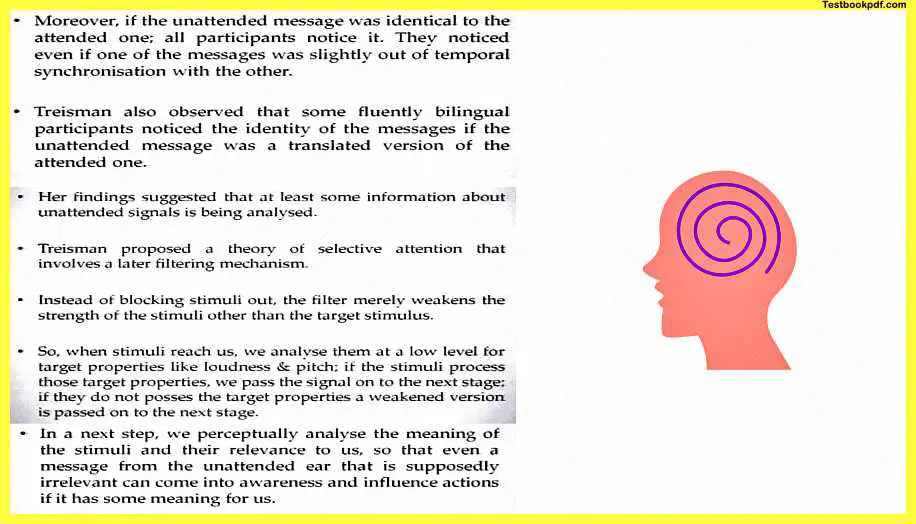
Now she had participants chorus shadowing these coherent messages and at some point what happened was that she switched the remainder of the message to unattended year so what is happening is again the dichotic presentation is happening some information is coming in the left here some information is present in the right ear.
Now what she is doing is that whatever information is playing in the attended year the shadowed here that is at some point in time that information from the shadowed ear switches to the unshadowed or the unattended year.
Now, what happened in the scenario some participants picked up the first few words of the message that they had been shadowing in the unattended year as well so there was some processing happening in the unattended year as well so they somehow must have been able to process whatever is going on in the unattended year even though they are shadowing this particular year moreover it was found that if the unattended message was identical to the attended one all the participants will notice it so they notice even if one of the messages slightly out of the temporal synchronization say for example you are talking to two people on phone also sometimes your headphones they get out of sync those kinds of things can happen and that that kind of differences people do notice.
Now trees men also observed that if there were some very fluently bilingual participants in the same kind of setup that I was talking about they will notice if the messages in the unattended year were translated versions of the attended one say for example if I am talking about a particular phenomenon here in English and a translation of this description in Hindi here I might still be able to follow what is going on as an attended year so unattended yet that is so this is also happening so some kind of semantic processing must be happening here as well.
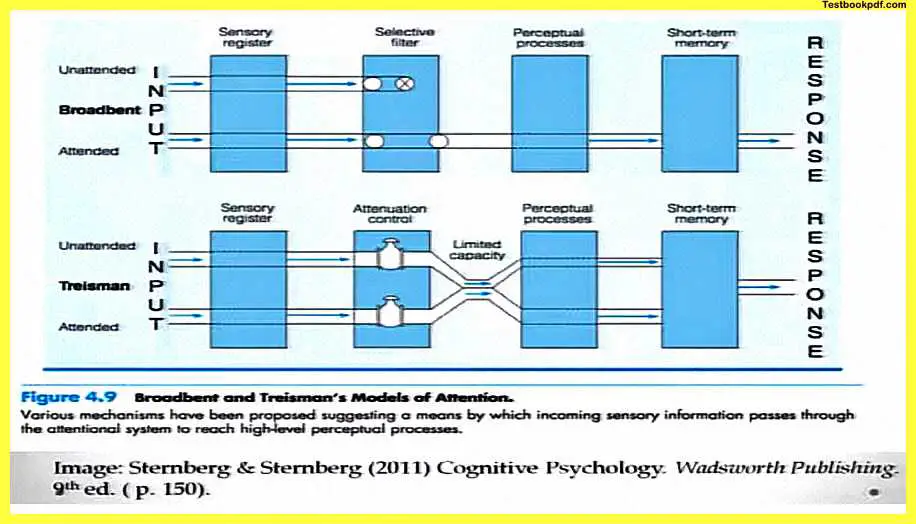
Now, these findings that trees been found out suggested that at least some information from the unattended year is also being analyzed its not only being sent being evaluated at the sensory level but it is analyzed at a higher level as well.
Now trees men account for all of these findings and propose a theory of selective attention that involves a slightly later filtering mechanism instead of blocking the stimuli out the filter is mainly weakening the strength of the stimuli other than the target stimulus so everything else is just getting slightly weakened and the filter is applied much later so when the stimuli reach we are analyzing them at a low level for target properties like loudness pitch etc but if the stimuli possess those target properties we pass the signal on to the next stage if they do not possess these kind of properties then we a very weakened version of these still gets passed on to whatever selection criteria you have given to this filter it will search for those selection criteria matching if something matches it is directly sent to the next stage if it does not match it is weakened and still send to the next stage.
Stimuli and their Relevance
Now the next step we perceptually analyzing the meaning we are perceptually analyzing the meaning of the stimuli and their relevance to us so that even a message from the unattended year is supposedly weaker.
Now and is irrelevant to us can come into awareness and influence actions if say for example it has some meaning for us even if I hear a faint version of my name in the unattended year i am still going to attend it even if this one is a translation of whatever is going on in the attended year I will listen to it here you can see the comparison of Broadbent and trees model you will notice that say for example while the broad mind is placing the filter selective filter just out of just after the sensory register trees one is basically doing some kind of attenuation control so there are two tabs ok one there is a direct capacity tab and the other is kind of limited capacity thing so again this is a metaphorical comparison of what the models of attention proposed by Broadbent and trees men are saying and very important theories have been very important in cognitive psychology.
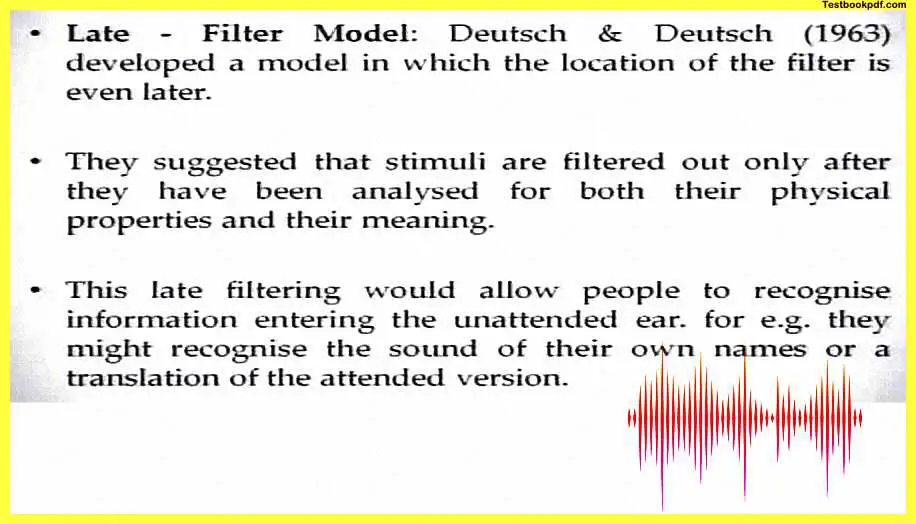
Now even later filter model has been proposed and Deutschen Deutsch developed the model in which the location of filters even later they suggested that the stimuli are filtered out after they have been analyzed for both their physical properties and they are being so they are saying Deutschen and Deutsch are saying that no it’s not like that we will not analyze the meaning of the unattended information we will do that as well and only after that we will throw it away.
So this late filtering would allow people to recognize information attending the unattended year information presented in the unattended ear as well for example they might recognize the sound of their own names or a translation of the unattended version this is what Deutschen Deutsch was saying they are saying that the selective filter is applied even after the perceptual processing has happened.
Now you can see how these three models differ from each other as to where this filter has been applied Ulric Neisser was going through all of these kinds of models and he wanted to synthesize the early filter and the late filter models.
So he proposed that there are two processes that govern selective attention first is the pre-attentive process these automatic processes are rapid and they are occurring in parallel and they can be used to notice only physical and sensory characteristics of the unattended message but they do not discern meaning so a very low-level analysis of the unattended message is happening the second process happens is the attentive or the control process these occur slightly later and they are executed serially so they happen one after the other they consume time and attention resources such as working memory.
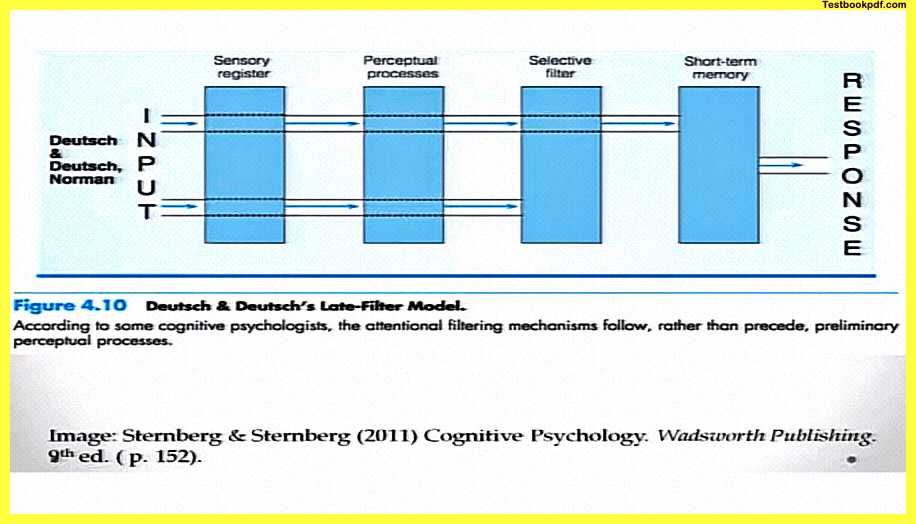
Now, these kinds of processes the second kind of process can be used as cues to observe the relationship among these features and synthesize fragments into mental representations of a particular object so once you are doing this second kind of processing on the unattended message you might be able to discern whether it has some relevance or meaning for you or not and if it does not have you throw it out if it does have it grabs your attention.
Now, this two-step model basically could seriously account for the cherries and mores increasements data also this model has been found to nicely incorporate aspects of treatments signal attenuation theory and feature integration theory also according to treatment discrete processes for feature detection and feature integration occur during searches which also are accounted for by this particular model let us come to the neuroscience of selective attention let us talk a little bit about that.
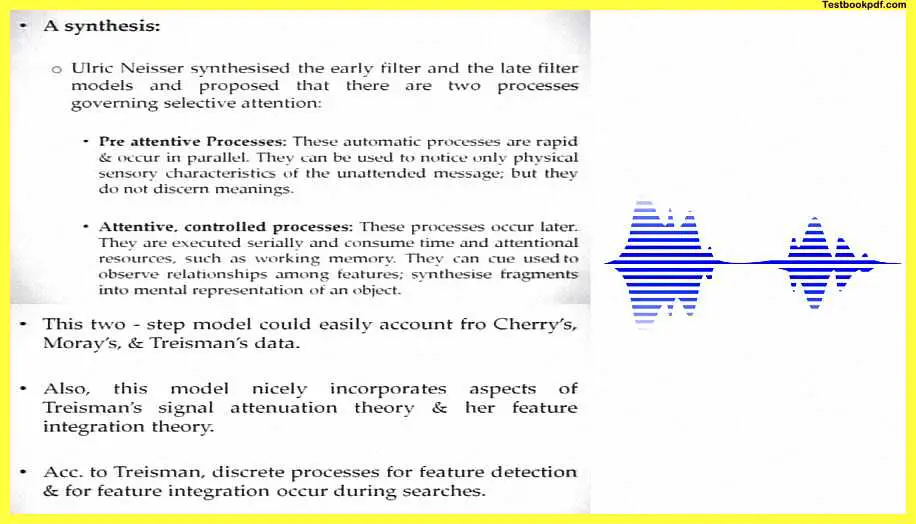
Now Hilliard and colleagues basically conducted a groundbreaking study and they exposed partisans to two streams of tones one in each year participants were asked to detect occasionally occurring target stimuli when the target stimuli occurred in the attended year the first negative component of ERP was larger even than when the target occurred in the second year the unattended year the first negative ERP component is the n1 wave okay which happens around after 90 milliseconds.
The researchers hypothesized that the n1 wave was the result of the enhancement of the target symbols because it is prioritized and enhanced at the same time there was a suppression of the other stimuli that were the distractors this result is consistent with filter theories of attention and later theories like once by Waldorf in 1993 found an even earlier reaction to a target stimulus in the form of a positive wave that occurs about 20 to 50 milliseconds after the onset of the target.
Heschel’s gyrus
Now, this wave originates in what is called the Heschel’s gyrus the auditory cortex and similar findings have also been reported for visual attention so if a target stimulus appears even in an unattended region of the visual fields the occipital p1 the p1 that is happening in the occipital cortex is larger than when the target appears in the unattended so you are seeing that there are different brain responses to stimuli coming in the attended and unattended fields and also depending on how much you want to enhance or attenuate that kind of information.
Now, this is all for today we have talked about selective attention we talked about the different kinds of theories that have talked about selective attention we saw that a very prominent theory of selective attention is the filter model we have talked about the fact that there were let us say the site of the filter is very important we saw that broadband is saying that the filter model should be applied much much earlier just after the sensory analysis of everything that is coming in we saw that Anne Treisman was saying that maybe the filter is not really weak putting everything out it is just weakening this information.
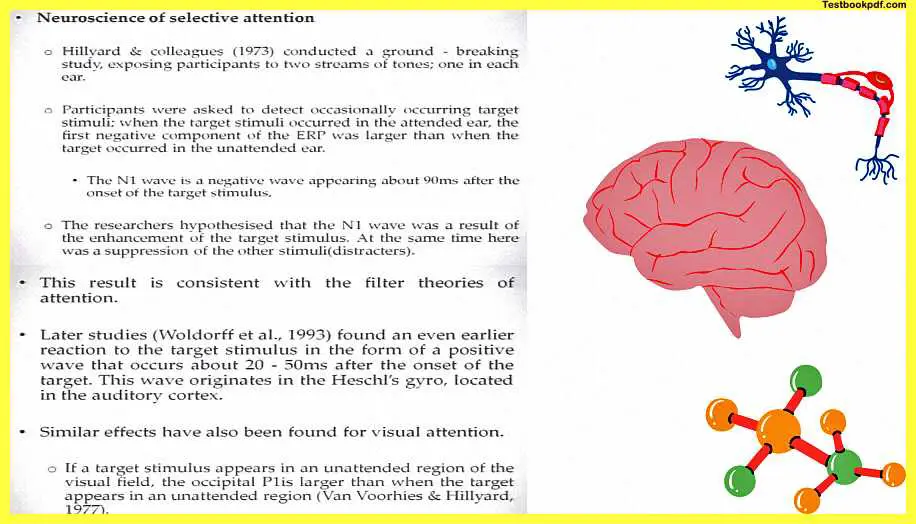
So it’s a limited capacity kind of a thing it’s a bottleneck kind of a thing and it is still letting everything pass but the one with higher priority passes faster and more directly the one with the slightly lower priority passes in a slower fashion it just gets weakened even though it gets analyzed as well we saw that there was this later model by Deutsche Deutsch which says sensory processing has happened perceptual processing has happened and only then the filter is applied.
So you see that there are consequences in terms of many mental processes as to which kind of filtering or selection mechanism that you are using in attention and there are also consequences for where in the entire processing you are putting this filter you are applying this particular filter and the more interesting part we saw towards the end of this lecture was Biolic Nizer when he said that let us kind of compile all of these three kinds of models and then see what kind of a model what kind of an integrated model one can come up with and his data the experiments that he did could account for a lot of findings which each of these separate models on their own could not so this was all about selective attention in the next class we will talk about divided detection thank you.
Read also:
Attention in Psychology Pdf (Part-1)
